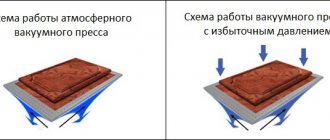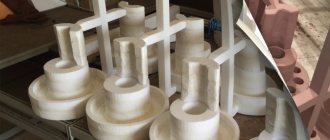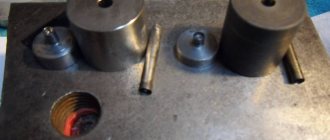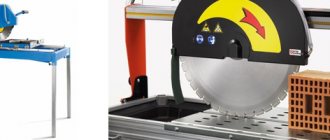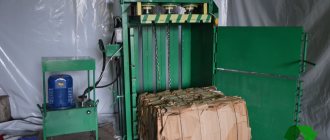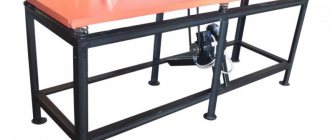In blow molding (pressure molding), a heated sheet of plastic placed between two molds is pressurized (hence the name) rather than being pulled around one mold using suction. Blow molding is well suited for making plastic parts or components that need to be shaped on both sides and/or require more draw (must be pulled deeper/further into the mold), such as appliance housings that need to look aesthetically pleasing from the outside and snap into place or fit to exact size on the inside.
Production stages
The first stage of vacuum forming is making the mold. It is created using laser cutting. As a rule, templates are made from MDF, because this material is best processed. But if the circulation is very large, it is recommended to make the form from aluminum.
When molding use:
- polystyrene;
- PVC plastic;
- acrylic;
- polycarbonate;
- PAT.
After the vacuum forming mold making process, the thermoplastic material needs to be heated to a specified temperature. In a heated state, the required shape is transferred using the matrix by creating a vacuum between the plastic and the matrix itself. Vacuum forming is used for concrete or plaster. They produce lamps, 3D wall elements, portholes for security cameras, bumpers and other car parts.
Thermal forming procedure is also very common. Using temperature, they create three-dimensional products of various shapes, as well as blanks from gypsum, plastic, acrylic organic glass and other polymers by combining them with a matrix. That is, the heated substance is, as it were, pulled onto the workpiece, which gives it its shape. In this way, it is possible to produce products of any shape with very thin walls. There are many different materials on the market today that can be vacuum thermoformed in one way or another. These are polyvinyl, acrylic (also called organic glass), sheet polymer, ABS plastic and others. The choice of material is an important factor, as it affects the complexity, depth and quality of the final part.
Vacuum Forming Process
The step-by-step process of vacuum forming is as follows.
- Fixation: A sheet of plastic is placed into the clamping frame and secured in place.
- Heating: The plastic sheet is softened by a heat source until it reaches the appropriate molding temperature and becomes pliable.
- Air evacuation: a frame with a heated, flexible sheet of plastic is lowered over the mold and pulled out by pumping air from the other side of the mold. For negative (or convex) shapes, tiny holes must be drilled at the kinks so that air can effectively pull the thermoplastic sheet into the appropriate shape.
- Cooling: Once the plastic has flowed around/in the mold, it needs to cool. When producing large items, fans and/or cold mist are sometimes used to speed up this stage of the production cycle.
- Removal: Once cooled, the plastic is removed from the mold and removed from the frame.
- Finishing: The finished part should be cleaned of excess material and its edges may be trimmed, sanded or smoothed.
Vacuum forming is a relatively fast process; The heating and air evacuation steps usually take only a few minutes. However, depending on the size and complexity of the parts being manufactured, cooling, finishing and mold production can take significantly longer.
Vacuum forming
In some cases, it will be advisable to use vacuum forming. Thermal vacuum formation is a very interesting and complex process that requires an extensive knowledge and skills, as well as qualified specialists.
The process is divided into several stages:
- the material is heated to a given temperature at which it can be plastic and change its shape without losing its characteristics;
- after this happens, the finished workpiece is removed and the surface is treated (trimming, grinding). The resulting product is not inferior in quality to a product that was formed by thermoforming or conventional molding.
Applications of Vacuum Forming
In the realities of modern society, it is difficult to spend at least one day without encountering an object that was obtained as a result of vacuum molding. This manufacturing process is used to produce a wide variety of parts for a wide variety of industries, including:
Automotive and transport
Vacuum forming is used to make various parts of cars, buses, ships and airplanes. In the automotive industry, everything from floor mats to bumpers and even truck beds are made using vacuum forming.
See the world's largest rotary vacuum forming machine in action.
Vacuum forming allows automotive companies to produce parts in a variety of colors and characteristics, while allowing designers to try out new prototypes during the development process.
Industry
Vacuum forming is also used to produce industrial boxes and machinery containers.
See how vacuum forming produces acrylic signs or skylights
Vacuum forming is great for making components that are primarily used outdoors or those that may come into contact with a heat source because it gives industrial manufacturers the ability to use a variety of flame-retardant and UV-resistant materials. For example, fire-resistant polyvinyl chloride (PVC, UL 94 V-0) and UV-transparent acrylic (PMMA) can be produced by vacuum forming.
Packaging and stands
If you buy a product that comes in a plastic package that matches its shape, there is a good chance that the packaging was vacuum formed. Razors, toothbrushes, electronics, makeup and cleaning products often come in vacuum-formed packaging.
Vacuum formed tray. (source)
Additionally, marketing shelving, marketing racks and merchandise end displays in grocery stores are often manufactured using vacuum forming.
Food packaging
Vacuum forming is often used to make food packaging because the method can process plastics intended to come into contact with food into products that are easy to sanitize.
These beautiful chocolates were made in vacuum formed molds and sit on a clear vacuum formed backing. To learn how to create chocolate molds using 3D printing technology, read our guide.
Fruit containers, plastic egg cartons, and cracker stands are often vacuum formed.
Consumer goods
The range of consumer products manufactured using vacuum forming is very wide. It includes products such as children's toys, travel products and home decor.
In this video you will see how a suitcase is made using vacuum forming.
Medicine
Medical devices and components that need to be sterile or contaminant resistant are often manufactured by vacuum forming.
This vacuum-formed backing provides safe storage for medical instruments. (source)
This includes medical packaging, pharmaceutical tablet trays, hospital bed components, and external parts of MRI and CT machines.
Non-standard products and special effects
Vacuum forming is used in a variety of industries to create custom and one-off products, such as special effects props.
In this video, Adam Savage explains the principles of vacuum forming and makes a custom stand.
PAT
It is very convenient in terms of vacuum forming; it does not exert high internal stress, so it can be easily melted and take any shape. It does not require pre-drying, as is the case with acrylic. The heat capacity properties are lower, and accordingly, the sheets are heated with less thermal energy, and the quality of the final product is not inferior to the materials and methods described above. PET is used to make mannequins, forms, signs, logos and more.
Vacuum Forming Materials
A variety of thermoplastics are used for vacuum forming. Among the most commonly used plastics are:
- Acrylic (PMMA)
- Acrylonitrile butadiene styrene (ABS)
- Polycarbonate (PC)
- Polyethylene (PE)
- Polyethylene terephthalate glycol (PETG)
- Polypropylene (PP)
- Polystyrene (PS)
- Polyvinyl chloride (PVC)
Price
The cost is calculated individually for each product. There are several factors on which it depends:
- First of all, this is the size of the product;
- shape, material, surface complexity;
- geometry;
- also affects seasonality (price is cheaper in summer);
- city (in capitals and large settlements where the production of molding is put on an assembly line), the price will be significantly lower than in cities where this technology has just begun to develop.
As a rule, the price of a specific product is calculated personally for each client. Moreover, if a client orders a large print run, then all prices for him become wholesale and are reduced accordingly.
Alexei
Leading specialist +7
Manufacturing cost calculator
Price
You can also send us a letter with a sketch drawing to receive an exact price and time frame
Advantages and disadvantages of vacuum forming
Many manufacturers, designers and others choose vacuum forming because it offers design flexibility at a relatively low cost compared to other production methods. Among the advantages of vacuum forming:
Affordable price
Particularly for low-volume production (250–300 units per year), vacuum forming is generally more economical than other production methods such as plastic injection molding. The affordable cost of vacuum forming is largely due to the lower cost of tooling and prototyping. Depending on the surface area of the parts being manufactured and the dimensions of the clamping frame, injection molding tooling can cost two to three times more than tooling for thermoforming plastics or vacuum forming.
Preparation time
Vacuum forming offers faster production times than other traditional production methods because tooling can be produced faster. Vacuum forming tooling typically takes half the time to produce than injection molding. If 3D printers are used to create the molds, production times can be reduced even further. Because vacuum forming improves the efficiency of the production process, businesses are able to get new product designs into the hands of consumers faster.
Flexibility
With vacuum forming, designers and manufacturers can test new designs and create prototypes without large overhead costs or time delays. Molds can be made from wood, aluminum, engineering foam, or 3D printed plastic, so they are relatively easy to replace and/or modify compared to other manufacturing processes.
In the late 1970s and early 80s, Dick Teal used vacuum forming to test prototype parts for John Deere snowmobiles, mainly because the technology made tooling cheaper to make. In the book John Deere Snowmobiles: Development, Production, Competition and Evolution, 1971–1983, the authors explain that “an economically win-win solution for all parties was achieved by low cost of parts and lower investments in tooling production.”
With vacuum forming technology, designers can work with a wide range of color options and make modifications to suit customer requirements. This opens up the opportunity for businesses to offer one-off designs and produce products with individual parameters, such as dental retainers, at an affordable price.
Production of sterile and food grade materials
Manufacturers often use vacuum forming to produce food containers and products for the medical industry because it produces plastics that can be sterilized or kept clean. For example, high-density polyethylene (HDPE) is often used to vacuum form food storage containers.
In addition, HDPE's resistance to acidic compounds makes it a suitable material for vacuum forming cleaning product containers. Vacuum forming of medical grade plastics is used to produce items that can be sterilized and meet stringent medical and/or pharmaceutical regulations.
Disadvantages of vacuum forming technology
Although vacuum forming offers significant advantages, it also has certain limitations. The vacuum forming method can only be applied to parts with relatively thin walls and simple geometry. However, the wall thickness of the finished parts may be uneven, and concave parts that require deep drawing are difficult to produce using vacuum forming.
Additionally, while vacuum forming is often the most cost-effective option for low- to medium-volume production, for high-volume production, other plastics production methods may be more cost-effective.
Reviews of our plastic products
We made equipment and parts for casting. We were completely satisfied with both the price of the molds and the quality of the casting. We continue cooperation. Mikhail, MirBTH LLC
We started working from scratch. The price of casting is completely satisfactory and the main thing is that you don’t have to constantly take care of the equipment. Andrey, Spetsmontazhprom LLC
We have been cooperating for more than 5 years in casting. The quality of the parts is pleasing and so is the flexibility of the management. We look forward to long-term cooperation. Vasily BytTekhnika LLC
We are making a gear to participate in the tender. Everything was done in a short time. We completed it within 1 month from the moment of ordering - before the product was released
Preparing the model. First mistake
There should be no negative angles in the model, i.e. all bevels and ends must have angles greater than 90 degrees. The side surfaces must have at least a minimum slope of 2-3 degrees so that the model can be easily removed from the matrix. The matrix must be made higher, because in the corners adjacent to the table, it is impossible to completely remove the air; this will give a smooth bend towards the table. It is better to cut off the lower part. How much higher to go depends on the thickness of the sheet, the power of the equipment and how much you will heat the polymer material.
Conclusion
Thermo-vacuum forming is an excellent way to produce housing for prototypes, MVPs and small series.
After testing the new case, we will most likely try to make the necessary changes to the existing matrix and use it for the production of small series. Thank you for your attention!
PS: 6 people from Habr are participating in the project. We are developing three versions of the software (including one on Ardupilot and are starting a version on ROS), we have made a shield board for Raspberry, two versions of the case, we have three prototypes and grandiose plans. This robot would not exist if not for Habr.
Rotary vane vacuum pumps for molding
The most common now and historically the very first mechanical vacuum pumps are platinum-rotor ones.
The technology has long been mastered, wide selection, low prices. What you need to pay attention to when choosing a rotary vane pump:
- There is no need for two-stage pumps, although they can be used.
- A filter is required in the pumping path to prevent debris from being sucked into the pump cavity from the operating table of the installation
- at the start, at the beginning of pumping, a rotary vane pump with an oil seal releases oil mist in the exhaust.
Since in the production of vacuum molding the starting mode is the main one, it is necessary to install a special trap for the sediment exhaust - an oil separator, and it is also worth making a separate pipeline for the pump exhaust gases from the room, or placing the pump in a separate room.
We recommend looking at the model range of pumps VARP Luna, VARP Alcor, Busch R5, 2НВР. Choose the one that is optimal for you in terms of performance and price.
Thermoforming of plastic
The plastic sheet must be preheated to give it the required shape. It is heated to a temperature at which it becomes elastic, but does not go into a molten state.
Important. The heating temperature is different for different types of polymers. So, polystyrene is heated to 110-150 degrees Celsius, and polycarbonate to 190-230 degrees.
After this, the sheet heated to a highly elastic state is pressed against the working surface of the vacuum forming machine.
After this, a powerful pump, by sucking out air, forms a vacuum in the cavity between the sheet and the form that forms the appearance of the product. In this case, the sheet, due to its temporary elasticity, tightly fits the molding part and completely conforms to it after cooling.
Important. The cooling time of the sheet in a rarefied environment depends on the characteristics of the material used and the wall thickness of the products.
Our production facilities
Our company uses a vacuum forming machine with overhead heaters. The equipment allows the use of the following material for vacuum forming:
- PVC;
- ABS plastic;
- polypropylene;
- polyethylene;
- PAT;
- polycarbonate and others.
The maximum size of sheet plastic used in production for vacuum forming is 1100 x 2500 mm, sheet thickness: from 1.2 to 7 mm.
Our machine for vacuum molding of plastic allows us to produce parts up to 600 mm deep. The work table for vacuum forming has the following dimensions:
- along the x-axis - 1100 mm;
- along the y-axis - 2500 mm;
- along the z axis - 850 mm.
The maximum size of sheet plastic used in production for vacuum forming is 1100 x 2500 mm, sheet thickness: from 1.2 to 7 mm.
Vacuum forming is a method of producing three-dimensional products from polymers at high temperature and vacuum. Unlike casting and injection molding, vacuum forming does not require the use of complex equipment and tooling, allows you to obtain large-sized products and reduces the final cost of production.
STP LLC offers vacuum molding services for plastics using its own equipment. We carry out orders for vacuum forming of both individual products and provide their serial production.
Production methods
The principle of vacuum molding of plastic is to give a sheet of plastic the required shape. To do this, at the initial stage, a product is made from metal or other dense material, which will give the shape to a sheet of heated plastic. At the next stage, using one of the methods listed below, the plastic is shaped into a sample product.
There are the following methods of thermoforming plastic:
- vacuum;
- pneumatic;
- hydraulic;
- mechanical;
- combined.
Let's take a closer look at the operating principle of equipment for vacuum thermoforming of plastic.

